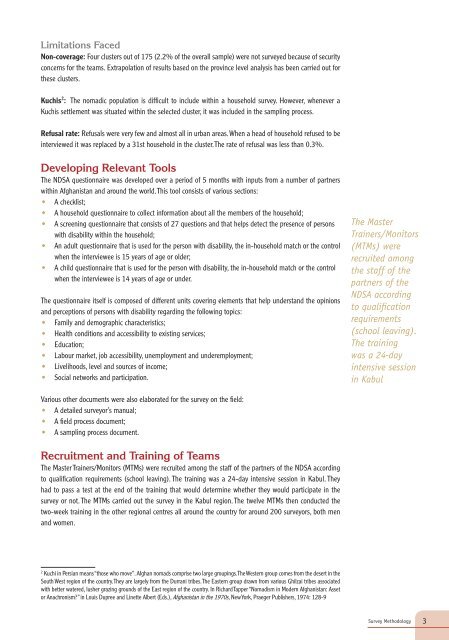Handicap International experience in Afghanistan - CBM
Handicap International experience in Afghanistan - CBM
Handicap International experience in Afghanistan - CBM
- No tags were found...
Create successful ePaper yourself
Turn your PDF publications into a flip-book with our unique Google optimized e-Paper software.
Limitations FacedNon-coverage: Four clusters out of 175 (2.2% of the overall sample) were not surveyed because of securityconcerns for the teams. Extrapolation of results based on the prov<strong>in</strong>ce level analysis has been carried out forthese clusters.Kuchis 2 : The nomadic population is difficult to <strong>in</strong>clude with<strong>in</strong> a household survey. However, whenever aKuchis settlement was situated with<strong>in</strong> the selected cluster, it was <strong>in</strong>cluded <strong>in</strong> the sampl<strong>in</strong>g process.Refusal rate: Refusals were very few and almost all <strong>in</strong> urban areas. When a head of household refused to be<strong>in</strong>terviewed it was replaced by a 31st household <strong>in</strong> the cluster. The rate of refusal was less than 0.3%.Develop<strong>in</strong>g Relevant ToolsThe NDSA questionnaire was developed over a period of 5 months with <strong>in</strong>puts from a number of partnerswith<strong>in</strong> <strong>Afghanistan</strong> and around the world. This tool consists of various sections:• A checklist;• A household questionnaire to collect <strong>in</strong>formation about all the members of the household;• A screen<strong>in</strong>g questionnaire that consists of 27 questions and that helps detect the presence of personswith disability with<strong>in</strong> the household;• An adult questionnaire that is used for the person with disability, the <strong>in</strong>-household match or the controlwhen the <strong>in</strong>terviewee is 15 years of age or older;• A child questionnaire that is used for the person with disability, the <strong>in</strong>-household match or the controlwhen the <strong>in</strong>terviewee is 14 years of age or under.The questionnaire itself is composed of different units cover<strong>in</strong>g elements that help understand the op<strong>in</strong>ionsand perceptions of persons with disability regard<strong>in</strong>g the follow<strong>in</strong>g topics:• Family and demographic characteristics;• Health conditions and accessibility to exist<strong>in</strong>g services;• Education;• Labour market, job accessibility, unemployment and underemployment;• Livelihoods, level and sources of <strong>in</strong>come;• Social networks and participation.The MasterTra<strong>in</strong>ers/Monitors(MTMs) wererecruited amongthe staff of thepartners of theNDSA accord<strong>in</strong>gto qualificationrequirements(school leav<strong>in</strong>g).The tra<strong>in</strong><strong>in</strong>gwas a 24-day<strong>in</strong>tensive session<strong>in</strong> KabulVarious other documents were also elaborated for the survey on the field:• A detailed surveyor’s manual;• A field process document;• A sampl<strong>in</strong>g process document.Recruitment and Tra<strong>in</strong><strong>in</strong>g of TeamsThe Master Tra<strong>in</strong>ers/Monitors (MTMs) were recruited among the staff of the partners of the NDSA accord<strong>in</strong>gto qualification requirements (school leav<strong>in</strong>g). The tra<strong>in</strong><strong>in</strong>g was a 24-day <strong>in</strong>tensive session <strong>in</strong> Kabul. Theyhad to pass a test at the end of the tra<strong>in</strong><strong>in</strong>g that would determ<strong>in</strong>e whether they would participate <strong>in</strong> thesurvey or not. The MTMs carried out the survey <strong>in</strong> the Kabul region. The twelve MTMs then conducted thetwo-week tra<strong>in</strong><strong>in</strong>g <strong>in</strong> the other regional centres all around the country for around 200 surveyors, both menand women.2Kuchi <strong>in</strong> Persian means “those who move”. Afghan nomads comprise two large group<strong>in</strong>gs. The Western group comes from the desert <strong>in</strong> theSouth West region of the country. They are largely from the Durrani tribes. The Eastern group drawn from various Ghilzai tribes associatedwith better watered, lusher graz<strong>in</strong>g grounds of the East region of the country. In Richard Tapper “Nomadism <strong>in</strong> Modern <strong>Afghanistan</strong>: Assetor Anachronism?” <strong>in</strong> Louis Dupree and L<strong>in</strong>ette Albert (Eds.), <strong>Afghanistan</strong> <strong>in</strong> the 1970s, New York, Praeger Publishers, 1974: 128-9Survey Methodology3
















